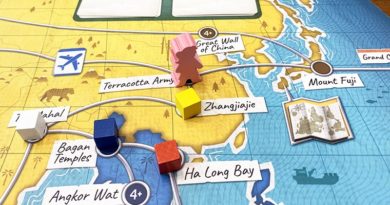Ticket to Ride Map Collection: United Kingdom & Pennsylvania board game review
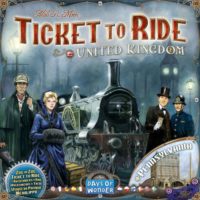
Ticket to Ride is one of the most popular modern family board games in the world today.
It was first published in 2004 and has taken the world by storm.
If you ask anyone involved in the board game industry for fun a board game that offers a great introduction to modern board games Ticket to Ride typically tops the list.
The card set-collecting, route-building, and ticket-completing is so straight forward it’s accessible and fun for players of almost any age.
That’s why it’s been #1 on our Top 10 Must Have Family Board Games list for years.
That’s also why the game has spawned countless expansions and new map collections.
And today we’re giving a closer look at the 5th volume in the Ticket to Ride Map Collection series – United Kingdom and Pennsylvania.
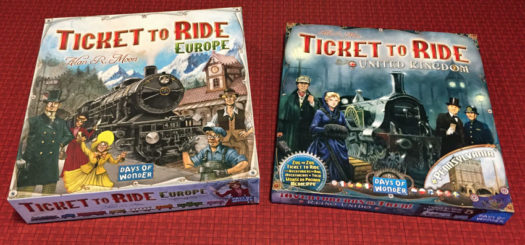
What’s in the game?
First, you should note that Ticket to Ride Map Collection: United Kingdom and Pennsylvania is a true game expansion. Meaning that you need to have one of the base games in order to play this game. We say “base games” as plural because for the original Ticket to Ride and Ticket to Ride Europe include all the color sets of trains and train cards needed to play on any of the expansion maps.
As you might surmise, the game comes with a double-sided board with a map of the United Kingdom on one side and Pennsylvania, USA on the other.
Inside you’ll also find a number of different sets of cards that are specific to the map you choose to play on – and that we’ll describe in detail below.
Since we typically like to combine our game expansions with the base games, we better point out that in this case, we don’t do that. The good news is that the map collection expansion box is a minimal box with a good insert that holds everything nicely and compactly.
Now let’s dive into the difference in game play…
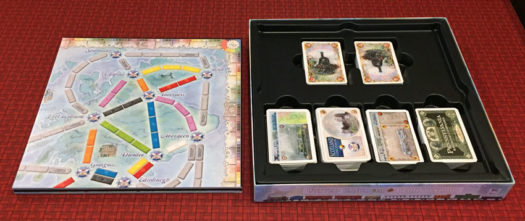
Ticket to Ride United Kingdom
The United Kingdom version of Ticket to Ride adds quite a few unique elements that spice up a game of Ticket to Ride.
The same essential game play is still solidly there: collecting train cards, turning in sets of cards to place trains between cities, and completing destination tickets. And the player with the most points at the end of the game wins.
However, the additions to the game give the game play itself a unique feel.
First of all, there’s a whole new deck of Train cards to play with when using the United Kingdom map. That’s because of the big new element in the game – Technologies!
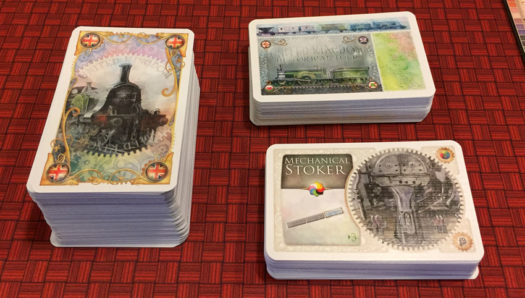
Since we’re dealing with islands in the UK, at the beginning of a game players can only claim 1 or 2 space routes. In order to place longer routes or connect across borders or waterways, players have to invest in technologies that will allow them to do so.
Technologies are represented with a separate deck of 47 cards. At the start of the game the different types of technologies are placed on the table in their separate stacks. In order to gain a new technology, players must pay the cost in Locomotive train cards. At the start of their turn, they can turn in Locomotive cards to claim a Technology card. Then then can take that technology card and place it in front of them.
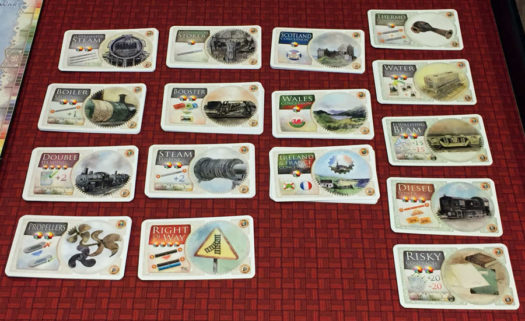
For example, in order to claim Ferry routes a player must first get a Propellers technology card that costs 2 Locomotives. Or in order to claim routes into any of the 5 cities in Wales, they must first get a Wales Concession technology card.
Because these technologies require Locomotive cards to claim, the new deck of Train cards in the United Kingdom game includes many more Locomotive cards than the standard base games of Ticket to Ride. Players can also turn in 4 of any color train card to equal 1 Locomotive card. And in addition to using Locomotives to gain technologies, players can also still use Locomotive cards as Wilds to claim routes.
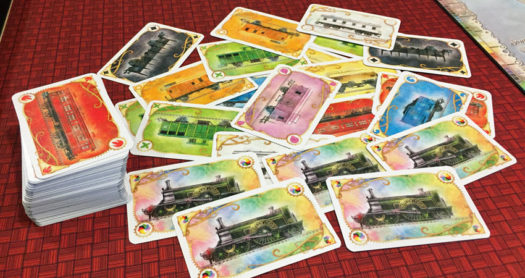
Most of the technologies in the game have 4 cards – so that even in 4-player games, no one is locked out of gaining certain technologies. However, there are also 5 Advanced Technologies that players could use in their games that have a limited number of cards available to claim.
For example, there’s only 1 Risky Contracts technology card. At the end of the game, if the player with this card has completed the most destination tickets, they’ll get an additional 20 points. However, if they don’t have the most completed tickets, they’ll lose 20 points!
A couple of technology cards grant special actions that are 1-time use actions and then the technology card is returned to the main area where it can be claimed again by any player.
Since the UK map has less land to cover than a standard map, players only use 35 trains in their stockpile. The game end is triggered the same way: once a player is down to their final 2 trains or less, the last round of the game is trigger.
There is no Globetrotter or Longest Route bonus in the UK version.
As always, the player with the most points wins.
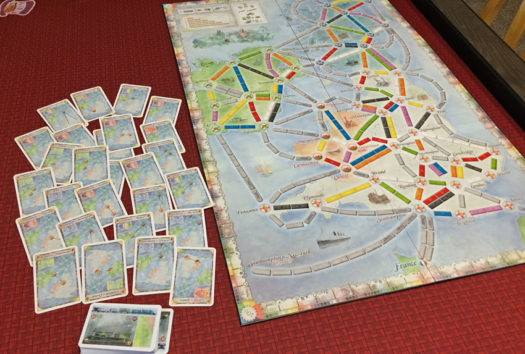
Ticket to Ride Pennsylvania
The other half of this game expansion dives into a U.S. state with a rich railroad history – Pennsylvania.
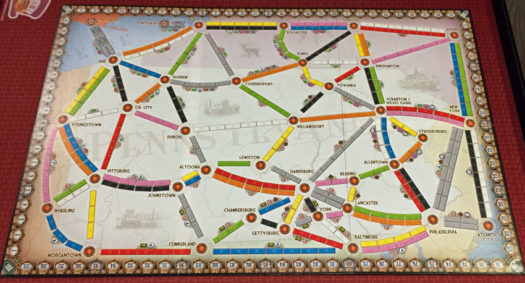
The big game changer with the Pennsylvania map is the addition of railroad company stock shares. In addition to building routes and completing destination tickets for points, players also compete to gain points with stocks in 9 railroad companies.
So the 2 new decks of cards in the Pennsylvania portion are Destination Tickets and Stock Shares. And players use the deck of Train cards from their Ticket to Ride base game.
Each railroad company has a different number of stock shares available at the start of the game. The stock shares are stacked for each company in order (with number 1 on top).
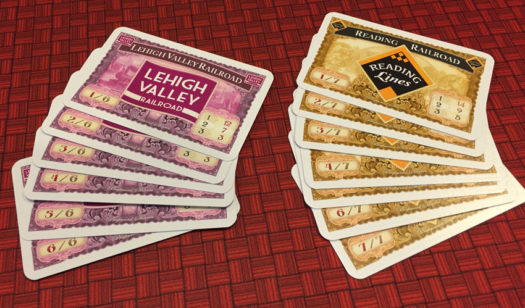
When a player completes a route between cities on the board, they may take a stock share from one of the companies depicted along that route. The player takes the top card from that company’s pile and places it facedown in front of them.
So in addition to gaining points for the completed route, they get a piece of a company.
Some routes don’t have a company logo next to them and some only have one company listed (so no choice in which stock to take).
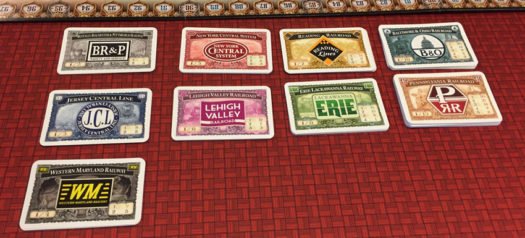
At the end of the game, in addition to scoring for completed Destination Tickets, players reveal their stocks and compare the amount of stock they have for each company. The front of each stock shows the points awarded. The player with the most shares of that company’s stock gets the top point value. The player with the second-most gets the next point value listed. Then the third-most shares and such on down the line.
If there’s a tie in the number of stock shares in a company between players, the player with the lower number share is considered to have more stock – because that player got in on that company’s stock earlier.
The player who completes the most Destination Tickets also gets a 15 point Globetrotter bonus to finish scoring.
The player with the most points wins!
Our thoughts on this Ticket to Ride Map Collection
Ticket to Ride is one of our favorite family board games. That means it’s also one of our most-played games as well.
So we’ve really enjoyed playing the UK / Pennsylvania versions because of the unique additions to the game. There’s just enough added twists and things to think about to keep it fresh without sacrificing the basic elements of the game.
When we first opened the game and pulled out the UK rulebook it was much thicker than we’d expected. So it was great to open it and realize that the UK version-specific rules were only a 2-page spread. The rest of the rulebook was the same thing repeated in 10 other languages. Whew.
The Pennsylvania rulebook is half as long because the rules are all contained on only 1 page per language.
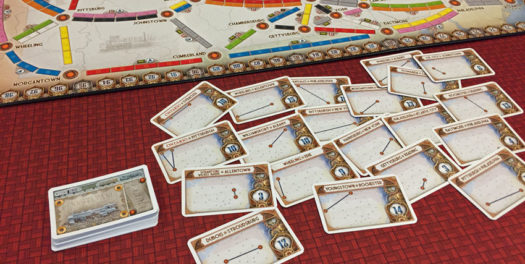
Just like we’ve listed out here, the first one we dove into was the UK version. It may be the same reason why we prefer the Europe version of Ticket to Ride over the original with the US map – we like thinking of traveling to those places in Europe and the UK when we play the game.
It was kind of strange when first playing the UK version to only claim 1 or 2 space routes. We caught ourselves a couple of times ready to claim routes of 3 or 4 length to only then realize we didn’t have the proper Technology yet to claim routes of that size.
And even later in the game we’d catch ourselves (or each other) when trying to extend into Scotland or Northern Ireland that we didn’t have the Technology card to connect to cities in those areas either. The good news is that by the end of the game we had a better handle on it.
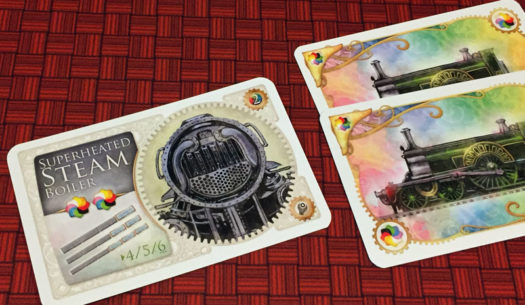
With the addition of the Technology cards, you might think the game would last longer since it adds an additional step. However, it really doesn’t for two reasons. The first is that claiming a Technology can be done at the start of your turn in addition to regular actions. So it doesn’t take a turn in and of itself.
The second reason is that each player starts with only 35 trains in their supply. So overall the game lasts about the same length of time as a standard game of Ticket to Ride.
In regards to the Pennsylvania version, collecting stock shares makes for interesting choices. Not only do players need to think about their Destination Tickets and the routes to connect to complete them, but also which railroad companies are along those routes. So there’s an added layer of strategy.
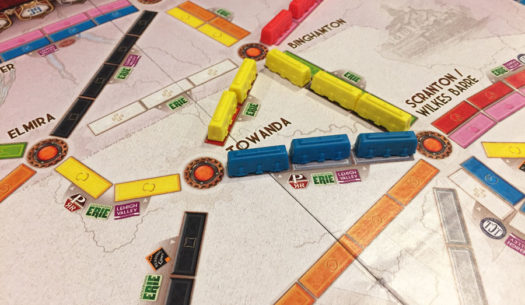
Sometimes it will make more sense to claim a distant route just to pick up certain company stock shares than to further extend an already connected chain of routes. It can also pay off to pay attention to which companies players are competing for and go for majority shares in the others companies.
Not all of us like that additional layer of strategy as much as the UK version. The UK version didn’t really add strategic elements, but rather it adds steps to claiming routes through new technologies. But the Pennsylvania map adds this strategy piece.
Which overall means the combination of UK and Pennsylvania together offer good variety to Ticket to Ride fans.
Another thing to point out is that we love the reference section on the UK map. In the top left of the map it shows not only the points for claiming different route sizes but it also shows reminders of the differences in the rules. It shows players’ starting train supply count as well as starting amount Train cards and Destination Tickets. It also shows the starting rules of only claiming 1 & 2 length routes in England and card conversion to equal Locomotives and drawing new Destination Tickets. It’s very handy.
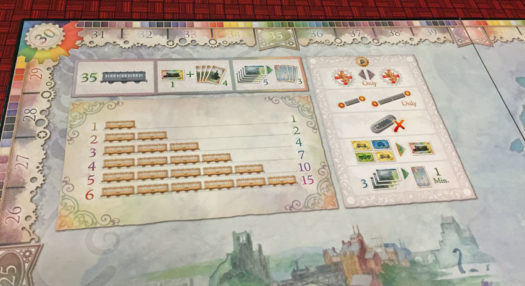
However, that same wonderful reference is completely missing from the Pennsylvania side of the board!
That’s a very bad oversight. Especially when you consider the UK side of the board shows points for 1 – 6 space routes yet the Pennsylvania side of the board includes 7 length routes. So you’ll have to remember the point values for those routes from the base game.
We guess they figure since you’re using trains from a base game that you’ll have the base game materials out anyway and can look over to them. But we still think the map and rules should stand on their own without needing to cross-reference.
That minor quibble aside, we give Ticket to Ride Map Collection: United Kingdom and Pennsylvania big thumbs up!
We’d like to thank Miniature Market for a review copy of Ticket to Ride Map Collection: United Kingdom and Pennsylvania.




